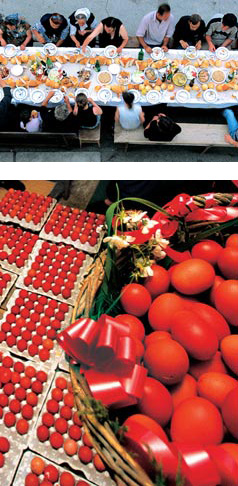National customs
Krsna slava

Krsna slava (a kind of patron saint’s day) is an ancient Serbian Orthodox tradition in which, alongside special rituals and a feast, the Christian saint, the protector of the family, is honoured, his day celebrated in accordance with the church calendar. The slava is a holiday of the ‘little church’ – the basic Christian cell, the family – when through prayer, the household remembers their ancestors who celebrated the same saint. Serbs celebrate their krsna slava with family, friends and festivities – a diverse range of food is prepared and a holiday atmosphere fills the home.
The most common Serbian slava, i.e. the most celebrated saints, are Saint Nicholas, Saint John, Saint Demetrius (Mitrovdan), Saint George (Đurđevdan) and Saint Archangel Michael (Aranđelovdan).Christmas traditions
The Nativity Fast begins 40 days before Christmas Day and has two aspects: spiritual and physical. The spiritual aspect of fasting is the abstention from evil thoughts and deeds. The physical aspect entails the complete avoidance of fatty foods, which includes all animal-sourced food products (meat, milk, dairy products and eggs). Fish may be eaten on certain days.
On Christmas Eve, the owner of the house goes out early in the morning to collect an oak branch (badnjak) which is brought into the house at sunset that evening. Christmas Eve dinner is strictly in accordance with church rules on fasting and bread is not cut by knife, but broken by hand. Apart from yeast-free round-bread, fish, honey, wine and bean stew are consumed, as well as walnuts, apples, pears, prunes, dates, other dried fruit, almonds and hazelnuts.The Nativity Fast ends on Christmas Day which Serbs celebrate according to the old Julian calendar, meaning that it falls on 7th January by the modern calendar. The položajnik is the first person to enter the house on Christmas morning and it is believed that he brings well-being to the home. He greets the household members by saying, “Christ is born!” (Hristos se rodi!) to which the household replies, “He is born indeed!” (Vaistinu se rodi!)
Christmas dinner is formal and consists of certain ceremonial foods which are only prepared on this day: Christmas pečenica (roasted whole pig) and česnica – a cake of wheat flour in which a coin is hidden and which is only broken by hand. Whoever finds the coin in their portion of bread will have good fortune for the next year!Easter traditions
Great Lent lasts for 40 days, from Clean Monday to Lazarus Saturday. During Great Lent, ”water-fasting” is done on Mondays, Tuesdays, Wednesdays, Thursdays and Fridays (no animal products or fats or olive oil allowed in food preparation), while “oil-fasting” is done on Saturdays and Sundays (when olive oil may be consumed).
Lazarus Saturday (Vrbica) falls on the Saturday before Palm Sunday, which is always the sixth Sunday of Great Lent. It is dedicated to the memory of the resurrection of Lazarus of Bethany and of Christ entering Jerusalem, where children waited to greet him. This is exclusively a holiday for children, who go to church that day and their parents buy them bells bound by ribbons in the colours of the Serbia flag and place them around their necks.Easter is a moveable feast and is celebrated after Jewish Passover, the first Sunday following the full moon which falls on the day of the spring equinox or immediately after it, but never before this. Easter can fall at the earliest on the 4th April or on the 8th May at the latest. Traditionally, boiled eggs are decoratively painted on Good Friday, a day during which no other work is done, and on Easter Sunday the eggs are eaten and people greet each other by saying, “Christ is risen!” (Hristos vaskrse!) and “He is risen indeed!” (Vaistinu vaskrse!)
